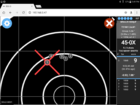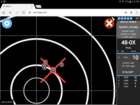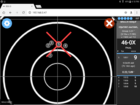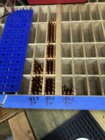Hi, as I told before my 284 Shehane is shooting very good with 180 VLD . I did a test today and it still prefers 180VLD with constant 0,15 MOA at 400 meters (around 440 yards) with 57,5 H4831SC @ 2955 fps . Best result with 180 Hybrid was 0,21 MOA at same distance with 57,8 H4831SC @ 3005 fps and with 184 Hybrid was 0,185 MOA with 57,8 H4831SC @ 2979 fps. It seems they shoot better with 20 thou jump . It was a quick test and further will come this month at 800 yards.
Install the app
How to install the app on iOS
Follow along with the video below to see how to install our site as a web app on your home screen.
Note: This feature may not be available in some browsers.
You are using an out of date browser. It may not display this or other websites correctly.
You should upgrade or use an alternative browser.
You should upgrade or use an alternative browser.
newly released BERGER 184 Hybrid (.284)... preliminary load data and results compared to 180 Hybrid
- Thread starter MontanaCreedmoor
- Start date
I would like to add bullet sorting with bullet comparator was showing a wide spread , around 6 thou and even with Bullet Genie control differences are huge . I didn’t find so big difference in weight : from 183.9 to 184.1
I found the same spread that you've reported after I sorted the 500 that I bought.I would like to add bullet sorting with bullet comparator was showing a wide spread , around 6 thou and even with Bullet Genie control differences are huge . I didn’t find so big difference in weight : from 183.9 to 184.1
BIGKEV: any load/grouping results yet?


 While I can’t argue with the measurements stated above I will say base to ogive measurements can be tricky to get accurately in some cases. Attached are some groups I shot at 1,000 yard using my new Solo electronic target. Notice the elevation figures. Avg =1.78" 7-270 WSM, 29" Barlein 5r, Panda F-Class action.
While I can’t argue with the measurements stated above I will say base to ogive measurements can be tricky to get accurately in some cases. Attached are some groups I shot at 1,000 yard using my new Solo electronic target. Notice the elevation figures. Avg =1.78" 7-270 WSM, 29" Barlein 5r, Panda F-Class action.LBART: Awesome groups! Like you say ..... the verticals on those are excellent.....!
What muzzle velocity are you running at?
What muzzle velocity are you running at?
LBART:
Are these groups on par with your previous BERGER 180’s? Or are you getting even better groups .... and ‘vertical spread’ with the new BERGER 184 F OPEN HYBRIDs?
Are these groups on par with your previous BERGER 180’s? Or are you getting even better groups .... and ‘vertical spread’ with the new BERGER 184 F OPEN HYBRIDs?
2950-2960fpsLBART: Awesome groups! Like you say ..... the verticals on those are excellent.....!
What muzzle velocity are you running at?
I think the 184's like this new barrel better than the 180 hybrids. But I haven't shot nor worked up a load for the 180 for it. The load I have decided to use for the LR FC Nat's is the same as what I used in my last barrel with 180's. No signs of pressure but a very knowledgeable friend had problems when he tried the same thing in his .284 Win. Be careful the bearing surface is much longer. Bare in mind I got 3 new things at one time....new bullets, new barrel and the Solo system. The Solo makes it much easier to test at 1k and gives you a lot of useful info. The new 184's are nice also! Barrel is 1-9", 29" long.
Last edited:
Ned Ludd
Silver $$ Contributor
View attachment 1059740 View attachment 1059745 View attachment 1059747 While I can’t argue with the measurements stated above I will say base to ogive measurements can be tricky to get accurately in some cases. Attached are some groups I shot at 1,000 yard using my new Solo electronic target. Notice the elevation figures. Avg =1.78" 7-270 WSM, 29" Barlein 5r, Panda F-Class action.
Larry, I'm afraid that load still needs some work before Nationals...9 out of 12 shots are in the 9-ring
Ned Ludd
Silver $$ Contributor
Ned,
The loads OK, the trigger puller needs a lot of work
All kidding aside, the trigger puller is doing very well indeed to shoot groups like that at 1000 yd. I'm not personally a big a fan of the idea of e-targets in F-Class competition, but this is a great example of how the use of an e-target can be a fantastic aid for long range practice and load development. Well done!
Just out of curiosity, it seems like several have started out loading the 184s with very similar charge weights they previously used with 180s. In terms of 1000 yd drops, does the slightly higher BC and slightly lower velocity (due to the 184's greater weight) more or less even out as compared to the 180s?
Ned, I don't bother checking drops. At 1k most days the elev changes a bit with the weather/wind conditions. I have at least 2 sighters in a match and where they go determines my knob setting. Plus a different bullet will give you different barrel vibrations and therefore different impacts. I would have to zero both the 184 & 180 @ say, 100 yds and then shoot them at 1k to see what the elev difference is from each one's 100 zero. Haven't done that.
NED:
On your question on 1,000 yard drops and DOPE/come-ups ..... shot 180 HYBRID side by side against the 184’ HYBRIDS in competition at 1,000 yards today.
This Data is for a specific load and velocity of course .... I’m Sure everyone else’s come-up will be a little different and will of course depend on elevations/BP/etc.
Come up for elevation DOPE on the 184 HYBRID was 27.00 MOA (2,795 FPS) from a “0” at 100 yards.
Come up for elevation DOPE on the 180 Hybrid was 26.75 MOA. (2,820 FPS) from a “0” at 100 yards.
Side by side in 1,000 yard competition setting .... so very similar conditions.
Looking like as long as you load at a similar velocity as you did for the 180 HYBRIDS, it looks like your Come-up for the 184 will be very similar .... maybe give it another 0.25 MOA .... and you’ll probably be dead on to your 180 DOPE.
On your question on 1,000 yard drops and DOPE/come-ups ..... shot 180 HYBRID side by side against the 184’ HYBRIDS in competition at 1,000 yards today.
This Data is for a specific load and velocity of course .... I’m Sure everyone else’s come-up will be a little different and will of course depend on elevations/BP/etc.
Come up for elevation DOPE on the 184 HYBRID was 27.00 MOA (2,795 FPS) from a “0” at 100 yards.
Come up for elevation DOPE on the 180 Hybrid was 26.75 MOA. (2,820 FPS) from a “0” at 100 yards.
Side by side in 1,000 yard competition setting .... so very similar conditions.
Looking like as long as you load at a similar velocity as you did for the 180 HYBRIDS, it looks like your Come-up for the 184 will be very similar .... maybe give it another 0.25 MOA .... and you’ll probably be dead on to your 180 DOPE.
Ned Ludd
Silver $$ Contributor
NED:
On your question on 1,000 yard drops and DOPE/come-ups ..... shot 180 HYBRID side by side against the 184’ HYBRIDS in competition at 1,000 yards today.
This Data is for a specific load and velocity of course .... I’m Sure everyone else’s come-up will be a little different and will of course depend on elevations/BP/etc.
Come up for elevation DOPE on the 184 HYBRID was 27.00 MOA (2,795 FPS) from a “0” at 100 yards.
Come up for elevation DOPE on the 180 Hybrid was 26.75 MOA. (2,820 FPS) from a “0” at 100 yards.
Side by side in 1,000 yard competition setting .... so very similar conditions.
Looking like as long as you load at a similar velocity as you did for the 180 HYBRIDS, it looks like your Come-up for the 184 will be very similar .... maybe give it another 0.25 MOA .... and you’ll probably be dead on to your 180 DOPE.
What I was really getting at and hoping Larry could offer some insight on was the real difference between the 180 Hybrids and new 184s. Although I don't shoot Open, there have been a couple recent offerings suitable for F-TR that are analogous to the 180/184 bullets.
Specifically, consider the example of a new bullet that has a slightly higher advertised BC, but which also comes along with a slightly greater bullet weight. The end result is that you may not be able to push the heavier bullet quite as fast, or at least they may tune in at a slightly slower velocity than the older, lighter bullet option. Armed with the BCs of the two bullets, it is a relatively simple exercise to calculate on paper how fast you have to push the heavier bullet in order to achieve some [theoretical] advantage in performance (i.e. resistance to wind deflection) over the older bullet. However, in the real world, drop at some specified distance is probably the easiest and most reliable method to distinguish between the two, as gauging wind deflection and its effect on score is far more subjective, hence my earlier question.
Unless the BC advantage of the heavier bullet is significant, or it tunes in at an equal velocity to the lighter lower BC bullet, you may well be left what appears to be two fairly equal possibilities in terms of ballistic performance. In that event, to make it worthwhile to make the effort to try out the new bullet, develop a load with it, and use it in competition, there should probably be some other perceived advantage such as dimensional consistency, ease of tuning, precision, etc. Otherwise, why make the effort if a noticeable improvement may be very difficult to quantify? This would be especially true in a case where a different twist rate or barrel length may required for the new bullet, or a different freebore/reamer spec. Although that doesn't seem to be the case with the 180/184 bullets, it IS the case with the F-TR caliber bullets I'm specifically thinking about. So I wanted to ask those with expertise using the 180/184 bullets what they perceive are the advantages of the new 184 over the 180 Hybrid, when it doesn't appear as though there is a great difference in wind deflection between the two after taking their respective velocities into account. Just curious, and the info may be useful in the decision making process when choosing between other similar bullet "pairs". My guess is that over time, we are likely to see even more bullets designs emerge where there is not a "quantum" leap in BC and understanding the thought process might be useful.
Last edited:
What I was really getting at and hoping Larry could offer some insight on was the real difference between the 180 Hybrids and new 184s. Although I don't shoot Open, there have been a couple recent offerings suitable for F-TR that are analogous to the 180/184 bullets.
Specifically, consider the example of a new bullet that has a slightly higher advertised BC, but which also comes along with a slightly greater bullet weight. The end result is that you may not be able to push the heavier bullet quite as fast, or at least they may tune in at a slightly slower velocity than the older, lighter bullet option. Armed with the BCs of the two bullets, it is a relatively simple exercise to calculate on paper how fast you have to push the heavier bullet in order to achieve some [theoretical] advantage in performance (i.e. resistance to wind deflection) over the older bullet. However, in the real world, drop at some specified distance is probably the easiest and most reliable method to distinguish between the two, as gauging wind deflection and its effect on score is far more subjective, hence my earlier question.
Unless the BC advantage of the heavier bullet is significant, or it tunes in at an equal velocity to the lighter lower BC bullet, you may well be left what appears to be two fairly equal possibilities in terms of ballistic performance. In that event, to make it worthwhile to make the effort to try out the new bullet, develop a load with it, and use it in competition, there should probably be some other perceived advantage such as dimensional consistency, ease of tuning, precision, etc. Otherwise, why make the effort if a noticeable improvement may be very difficult to quantify? This would be especially true in a case where a different twist rate or barrel length may required for the new bullet, or a different freebore/reamer spec. Although that doesn't seem to be the case with the 180/184 bullets, it IS the case with the F-TR caliber bullets I'm specifically thinking about. So I wanted to ask those with expertise using the 180/184 bullets what they perceive are the advantages of the new 184 over the 180 Hybrid, when it doesn't appear as though there is a great difference in wind deflection between the two after taking their respective velocities into account. Just curious, and the info may be useful in the decision making process when choosing between other similar bullet "pairs". My guess is that over time, we are likely to see even more bullets designs emerge where there is not a "quantum" leap in BC and understanding the thought process might be useful.
Ned, to your line of question, indeed even the ultrahigh BC195’s are hard put to achieve “match” world advantages over the 180’s. Weight, pressure on brass, barrel wear considerations, potential unwrapping in flight, these all combine to keep MV near the drift envelope of 180’s, at least assuming you have a shred of attachment to your barrel and brass. I would surmise the 184’s will have an even harder time separating themselves than 195’s. But Larry and some others have mentioned potentially tighter groups, and that sure matters.
This isn’t about 195’s, but I sure enjoyed my time with those and would welcome a vetted yellow box match version. They ship with gorgeous points. A friend has “lost” some of them in match conditions. If they were proofed up by Berger for really hot barells, so that we didn’t have to worry about that, then brass and barrels be damned, - I for one would convert.
Ned Ludd
Silver $$ Contributor
I agree. If the ballistic performance of two bullets were about the same, but one was more uniform out of the box, easier to load and tune, and/or grouped slightly better, I'd choose it in a heartbeat. Even one or two points/Xs an make the difference in a match, but there is always a certain amount of time, effort, and $$$ involved in changing components. Just wanting to hear some personal opinions on the 184s versus the 180s from those with firsthand experience.
I agree , I’ve tested deeply Berger 7mm 195 EOL on a 7-270 WSM 8 twist and they were @ 3050fps superior to 180 hybrid @ 3140 on a 9 twist barrel , no doubts at 1000yards. Only one problem : they blow up sometimes at that speed at that spin at 77 F degrees . IMHO the 195 should be the perfect bullet for Fclass with a match jacketNed, to your line of question, indeed even the ultrahigh BC195’s are hard put to achieve “match” world advantages over the 180’s. Weight, pressure on brass, barrel wear considerations, potential unwrapping in flight, these all combine to keep MV near the drift envelope of 180’s, at least assuming you have a shred of attachment to your barrel and brass. I would surmise the 184’s will have an even harder time separating themselves than 195’s. But Larry and some others have mentioned potentially tighter groups, and that sure matters.
This isn’t about 195’s, but I sure enjoyed my time with those and would welcome a vetted yellow box match version. They ship with gorgeous points. A friend has “lost” some of them in match conditions. If they were proofed up by Berger for really hot barells, so that we didn’t have to worry about that, then brass and barrels be damned, - I for one would convert.
Similar threads
- Replies
- 8
- Views
- 1,347
- Replies
- 4
- Views
- 2,057
- Replies
- 25
- Views
- 4,253
Upgrades & Donations
This Forum's expenses are primarily paid by member contributions. You can upgrade your Forum membership in seconds. Gold and Silver members get unlimited FREE classifieds for one year. Gold members can upload custom avatars.

Click Upgrade Membership Button ABOVE to get Gold or Silver Status.
You can also donate any amount, large or small, with the button below. Include your Forum Name in the PayPal Notes field.
To DONATE by CHECK, or make a recurring donation, CLICK HERE to learn how.

Click Upgrade Membership Button ABOVE to get Gold or Silver Status.
You can also donate any amount, large or small, with the button below. Include your Forum Name in the PayPal Notes field.
To DONATE by CHECK, or make a recurring donation, CLICK HERE to learn how.










